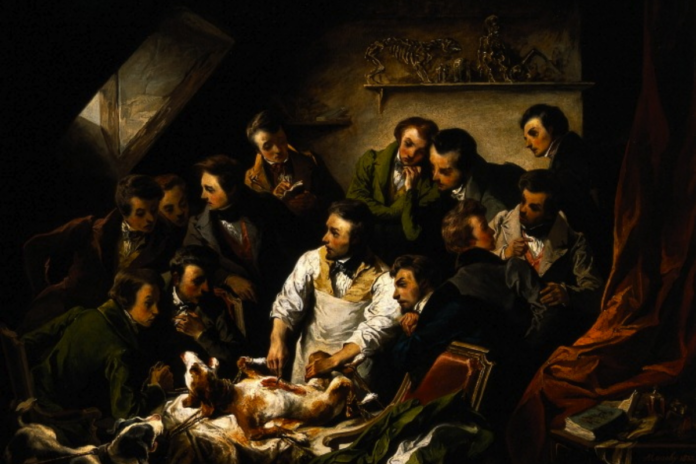Lindsey Fitzharris.
In 1664, Robert Hooke, a pioneering member of the Royal Society and a leading scientific thinker of his era, chose to examine the mechanisms of breathing.
In his laboratory, he secured a stray dog to his table and proceeded to use his scalpel to remove the terrified animal’s chest, allowing him to observe the thoracic cavity.
Also Read: A City of the Dream
Unforeseen Consequences Of Hooke’s Experiment On Breathing
Before commencing his experiment, Hooke had not realized that lungs were not muscular organs. Consequently, by removing the animal’s chest, he inadvertently deprived the dog of its ability to breathe independently. To sustain the animal’s life, Hooke inserted a hollow cane into its throat, reaching the windpipe.
He then utilized a bellow to pump air into the dog’s lungs for over an hour, meticulously observing the expansion and contraction of the organs with each artificial breath. The dog gazed at him in terror throughout the ordeal, incapable of whimpering or vocalizing its distress.
In a letter to Robert Boyle dated November 10, 1664, Hooke recounted his experiment, explaining how he had opened the dog’s thorax and removed all its ribs, allowing him to manipulate its body as he wished. Despite the grim nature of his actions, Hooke’s words reveal a man profoundly affected by the suffering he had inflicted. He concluded his letter by expressing reluctance to conduct similar trials in the future, citing the anguish endured by the creature as a significant deterrent.
The Historical Roots And Evolution Of Vivisection
The term “vivisection,” denoting the act of dissecting live animals or humans, was coined in 1709. However, this practice has a longstanding tradition dating back thousands of years. One of the earliest documented instances occurred around 500 B.C. when Alcmaeon of Croton severed the optic nerves of live animals to study their visual perception.
Notably, vivisection played a crucial role in advancing scientific understanding, as evidenced by William Harvey’s groundbreaking discovery of blood circulation around the heart in 1628, which was facilitated by his use of vivisection techniques. It is probable that Harvey’s pioneering work inspired Robert Hooke to undertake his own experiments several decades later.
While Hooke may have refrained from further vivisections upon witnessing the distress he caused in the dog, others were not necessarily inclined to cease such experiments solely due to the suffering experienced by animals.
Vivisection: A Training Tool For Surgeons In Early Modern England
During the pre-anesthetic era, vivisection served as a valuable tool for surgeons-in-training, aiding them in developing speed and confidence in their surgical skills. In a time when even the slightest hesitation could prove fatal for patients due to shock and blood loss, working on live animals allowed inexperienced surgeons to operate at their own pace.
This approach enabled them to learn from their mistakes without the risk of inadvertently causing harm to another human being. In early modern England, a society where bear-baiting and cock-fighting were popular pastimes akin to modern-day football or rugby, the acceptance of extreme suffering in animals under such conditions was commonplace.
During this period, objections to vivisection did exist, albeit not primarily centered on concerns about animal cruelty. Instead, many protests focused on the argument that animals and humans differed too significantly anatomically for vivisection to yield useful results. Nevertheless, there were individuals who voiced objections to vivisection on grounds of defending the rights and welfare of animals.
He engages in these cruel acts under the belief that they may benefit humanity. However, Pope questions the justification of taking the lives of creatures like dogs, which we consider ourselves only slightly superior to, for the sake of our curiosity or potential utility to us.
Samuel Johnson, renowned essayist and author of “A Dictionary of the English Language,” expressed his opposition to vivisection in the “Idler” (August 1758). He denounced the individuals he referred to as a “race of wretches” whose lives revolved around various forms of cruelty. Johnson criticized their favorite pastime of immobilizing dogs on tables and dissecting them while they are still alive.
Reality of Animal Cruelty: Testimony from Mr. Richard Martin
The portrayal of a live dog being affixed to a table may appear exaggerated, designed to evoke disgust and horror. However, this depiction is not hyperbolic, as confirmed by the testimony of Mr. Richard Martin. In 1825, Martin introduced a bill to the Irish House of Commons aimed at curbing bear-baiting and other acts of cruelty towards animals.
A Frenchman named Magendie conducted experiments so shocking that they almost defy belief. At one of his anatomical demonstrations, Magendie subjected a lady’s greyhound to extreme cruelty.
He immobilized the dog by nailing its front and hind paws with blunt spikes, claiming that sharper ones might cause the animal to tear away in agony. He then affixed its long ears in a similar manner.
Magendie proceeded to make a deep incision down the middle of the dog’s face, dissecting all the nerves on one side. Following these gruesome procedures, Magendie addressed the spectators, stating that he had completed operations on one side of the dog’s head and would continue on the other side the next day if the servant took care of the animal overnight.
However, he ominously remarked that if not, despite the dog’s diminished vivacity, he would still have the opportunity to dissect it alive and demonstrate the motion of the heart.
The Complex Legacy Of Vivisection In Early Modern Medicine
The tales of cruelty, such as those exemplified by M. Magendie’s experiments, are deeply unsettling and shed light on the sadistic tendencies of some medical practitioners during this era. However, it would be erroneous to generalize that all individuals conducting vivisections were cold-hearted and deliberate in their actions, as evidenced by Hooke’s letter to Boyle.
Nevertheless, it is crucial to acknowledge that many groundbreaking discoveries in medical science emerged from vivisection practices. To these animals, we owe a significant debt for the advancements made in medicine during the early modern period.


